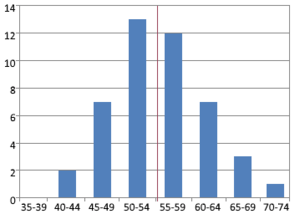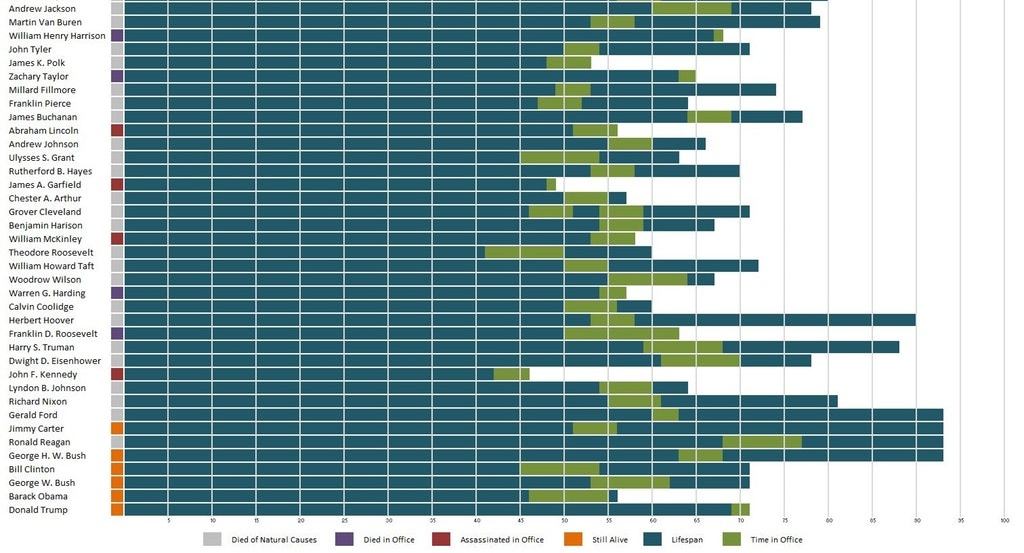Interestingly, of the 44 presidents sworn to office since 1789, there is quite a range in the starting points of presidencies, going from 42 years (Teddy Roosevelt) to 70 years (Donald Trump). The average age for inauguration, however, is at the center of this bell curve at 55 years old:
Today’s data visualization, which comes from Reddit, shows a timeline of the life of each president, highlighting when they were inaugurated, when they left office, and when they eventually passed away (or their current age, if still alive).
The Oldest Presidents
At an age of 70 years old, Donald Trump edges out Ronald Reagan (69 years) as the oldest person to be inaugurated as president in the country’s history. However, because Reagan served two terms, it is possible that Trump will not be able to beat Reagan as the oldest U.S. president at the time of leaving office. Reagan was 77 years, 349 days when he finished his second term. Reagan lived for the third-longest of all presidents, but was beat out by Gerald Ford, who lived to the age of 93 years and 165 days. Very recently, George H.W. Bush recently became the oldest person to have previously served as president – he turns 94 in June 2018.
Unexpected Ends
As you can see in the visualization, there were eight presidents to die while in office. Lincoln, Garfield, Mckinley, and JFK were assassinated – all by gunshot. Meanwhile, Harrison, Taylor, Harding, and FDR died of natural causes in office.
The Youngest Presidents
The youngest president was Teddy Roosevelt at age 42. Even though Barack Obama was viewed as young when he started his first term at age 47 – he was actually edged out by JFK (43 years), Bill Clinton (46 years), and Ulysses S. Grant (46 years) as well. on Even while political regimes across these countries have changed over time, they’ve largely followed a few different types of governance. Today, every country can ultimately be classified into just nine broad forms of government systems. This map by Truman Du uses information from Wikipedia to map the government systems that rule the world today.
Countries By Type of Government
It’s important to note that this map charts government systems according to each country’s legal framework. Many countries have constitutions stating their de jure or legally recognized system of government, but their de facto or realized form of governance may be quite different. Here is a list of the stated government system of UN member states and observers as of January 2023: Let’s take a closer look at some of these systems.
Monarchies
Brought back into the spotlight after the death of Queen Elizabeth II of England in September 2022, this form of government has a single ruler. They carry titles from king and queen to sultan or emperor, and their government systems can be further divided into three modern types: constitutional, semi-constitutional, and absolute. A constitutional monarchy sees the monarch act as head of state within the parameters of a constitution, giving them little to no real power. For example, King Charles III is the head of 15 Commonwealth nations including Canada and Australia. However, each has their own head of government. On the other hand, a semi-constitutional monarchy lets the monarch or ruling royal family retain substantial political powers, as is the case in Jordan and Morocco. However, their monarchs still rule the country according to a democratic constitution and in concert with other institutions. Finally, an absolute monarchy is most like the monarchies of old, where the ruler has full power over governance, with modern examples including Saudi Arabia and Vatican City.
Republics
Unlike monarchies, the people hold the power in a republic government system, directly electing representatives to form government. Again, there are multiple types of modern republic governments: presidential, semi-presidential, and parliamentary. The presidential republic could be considered a direct progression from monarchies. This system has a strong and independent chief executive with extensive powers when it comes to domestic affairs and foreign policy. An example of this is the United States, where the President is both the head of state and the head of government. In a semi-presidential republic, the president is the head of state and has some executive powers that are independent of the legislature. However, the prime minister (or chancellor or equivalent title) is the head of government, responsible to the legislature along with the cabinet. Russia is a classic example of this type of government. The last type of republic system is parliamentary. In this system, the president is a figurehead, while the head of government holds real power and is validated by and accountable to the parliament. This type of system can be seen in Germany, Italy, and India and is akin to constitutional monarchies. It’s also important to point out that some parliamentary republic systems operate slightly differently. For example in South Africa, the president is both the head of state and government, but is elected directly by the legislature. This leaves them (and their ministries) potentially subject to parliamentary confidence.
One-Party State
Many of the systems above involve multiple political parties vying to rule and govern their respective countries. In a one-party state, also called a single-party state or single-party system, only one political party has the right to form government. All other political parties are either outlawed or only allowed limited participation in elections. In this system, a country’s head of state and head of government can be executive or ceremonial but political power is constitutionally linked to a single political movement. China is the most well-known example of this government system, with the General Secretary of the Communist Party of China ruling as the de facto leader since 1989.
Provisional
The final form of government is a provisional government formed as an interim or transitional government. In this system, an emergency governmental body is created to manage political transitions after the collapse of a government, or when a new state is formed. Often these evolve into fully constitutionalized systems, but sometimes they hold power for longer than expected. Some examples of countries that are considered provisional include Libya, Burkina Faso, and Chad.

















